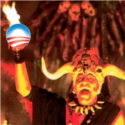|
Responding to a FR post from a few pages back:Arivia posted:I was honestly surprised by how many deities came from real-world pantheons. I knew about Loviatar and Oghma, but I hadn't read the deity section of the Old Gray Box before, so it was a little surprising. (Legends and Lore & Deities and Demigods are the same book, just two different printings with different names.) In the article in Dragon Magazine #54 that introduced the gods of the Realms, Greenwood spelled out the inspirations for the FR deities. More than half of them started out as repurposed gods taken directly from Deities & Demigods:
And Loviatar, Mielikki, Oghma, and Silvanus are all directly lifted from mythology (well, from the Deities & Demigods versions of mythology), albeit in slightly skewed forms.
|
|
|
|

|
| # ¿ Apr 25, 2024 23:01 |
|
pospysyl posted:What a story! It’s pretty dang good. The problem is that it literally tells you that our hero’s life pre-Werewolf is crappy. The “homeless people have it great!” moral is also a little disconcerting. It’s one thing to believe that homeless people deserve their misery, but to actually believe that they’re better off homeless is, to my mind, even worse. That's been a recurring theme of the Bone Gnawers ever since their inception - if anything, it was even worse in the earliest sourcebooks, where the majority of Bone Gnawer NPCs and suggested character concepts were some variation on the Wise and Magical Homeless Person stock character.
|
|
|
|
DAD LOST MY IPOD posted:They appeared in the ill-fated Mystara Monstrous Compendium Appendix and there are a TON of monsters from that book in this adventure, leading me to believe that they were directed to push it with this adventure. Nightwalker, Fundamentals, Magen, and one that's worse than all of them coming up later. Monte Cook worked on both the AD&D 2e Mystara setting and the Return to the Tomb of Horrors, which is probably why content from the former showed up in the latter. Likewise, some Mystara material popped up in his Planescape work: a few of the monster showed up in the later Planescape Monstrous Compendiums, and the random tiefling trait table in the Planewalker's Handbook looks to be inspired by the table for magic-blooded characters in the Glantri: Kingdom of Magic boxed set. And of course both Planescape and Mystara content popped up in the 3e core books that he worked on; the Planescape content is more obvious and pervasive, but there's Mystara material both in the Monster Manual (aranea, athach, nightshade) and the Epic Level Handbook (blackball, brain collector).
|
|
|



